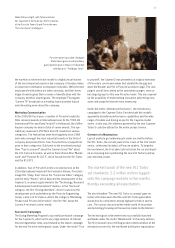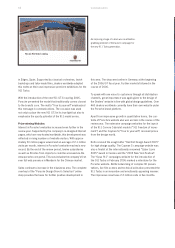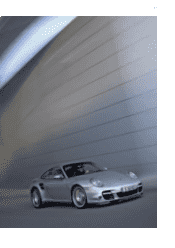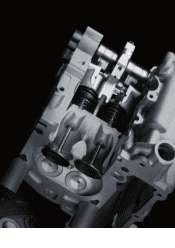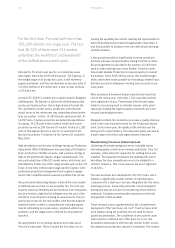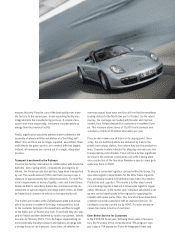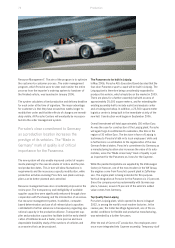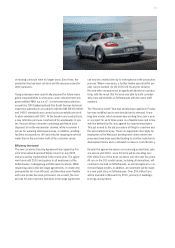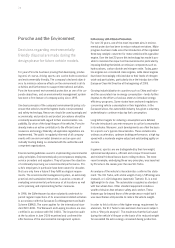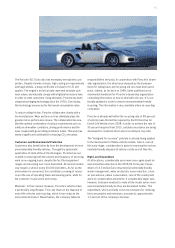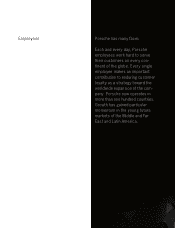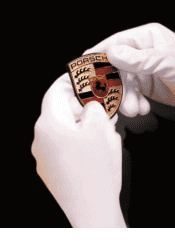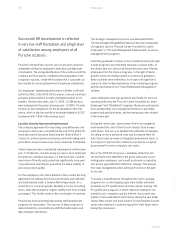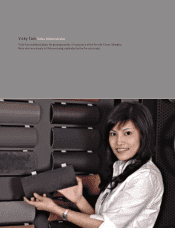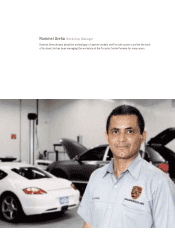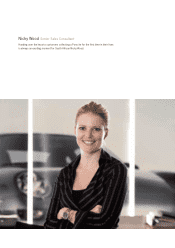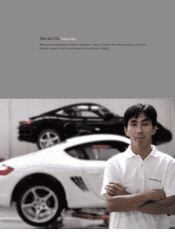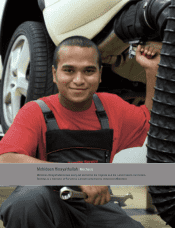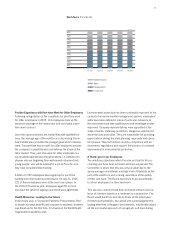Porsche 2005 Annual Report Download - page 77
Download and view the complete annual report
Please find page 77 of the 2005 Porsche annual report below. You can navigate through the pages in the report by either clicking on the pages listed below, or by using the keyword search tool below to find specific information within the annual report.
75
The Porsche 911 Turbo also has exemplary aerodynamic pro-
perties. Despite its wide chassis, high cooling air requirements
and large wheels, a drag coefficient (cD value) of 0.31 still
applies. The engine’s technical data represent absolute opti-
mum values and naturally comply with all global emissions laws.
In order to meet customers’ rising demands, Porsche has been
using turbocharging technology since the 1970s. Even today,
this technology ensures by far the lowest consumption rates.
To reduce rolling friction, Porsche collaborates closely with a
tire manufacturer. Wear and tear on tires ultimately plays the
greater role in performance losses. The collaboration has ena-
bled the optimal combination of various requirements such as
safety in all weather conditions, driving performance and life-
span coupled with good rolling resistance levels. This work has
made a significant contribution to reducing CO2emissions.
Customers and Environmental Protection
Customers also benefit directly from the development of more
environmentally-friendly vehicles. Through the systematic
application of state-of-the-art technologies, Porsche has suc-
ceeded in reducing both the volume and frequency of servicing
work on an ongoing basis, despite the fact that equipment
ranges are becoming ever more diversified. All current models
only require a service every 30,000 kilometers. As far as the
environment is concerned, this constitutes a saving of resour-
ces in the use of operating fluids and wearing parts, while for
the customer it saves time and money.
Moreover, to their owners’ pleasure, Porsche’s vehicles have
a particularly long lifespan. This cuts down on the disposal of
end-of-life vehicles and recycling, which in turn reduces the
environmental impact. Nevertheless, the company takes its
responsibilities seriously. In cooperation with Porsche’s dealer-
ship organization, the structures imposed by the European
Union for taking back and recycling old cars have been put in
place. Indeed, as far back as 1998, Sales published an en-
vironmental handbook for Porsche’s dealership organization
containing information on how to deal with old cars. It is con-
tinually updated in order to ensure environmentally-friendly
recycling. The information is also available online to recycling
companies.
Porsche is already well within the recycling rate of 85 percent
of vehicle mass that will be required by the EU Directive for
End-of-Life Vehicles from 2008. In order to achieve the rate of
95 percent required from 2015, suitable procedures are being
developed for materials that cannot currently be recycled.
The “designed for recovery” principle is already being applied
to the development of future vehicle models. Hence, even at
this early stage, consideration is given to ensuring the environ-
mentally-friendly disposal of vehicles at the end of their life.
High-Level Expenditure
At all locations, considerable sums were once again spent on
environmental protection in the 2005/06 fiscal year. Expen-
diture of 15.5 million Euro ensured environmentally-friendly
waste management, water protection, noise reduction, clean
air precautions, nature conservation, care of the countryside
and soil contamination prevention. A considerably larger sum,
however, has been invested to make all the model series more
environmentally-friendly as they are developed further. This
expenditure, which primarily concerns measures for reducing
fuel consumption and emissions, amounts to approximately
1.7 percent of the company’s turnover.


